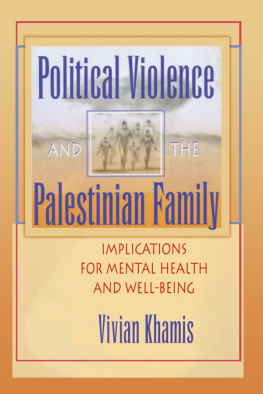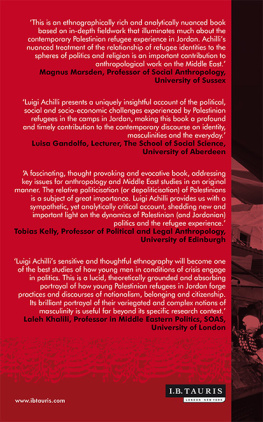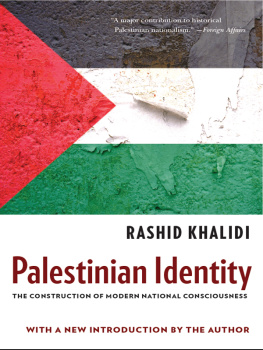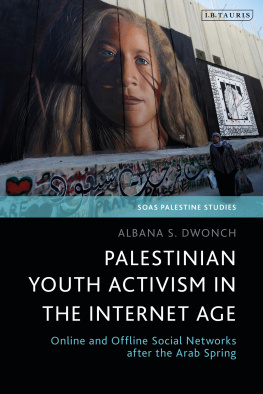Jordanes Palestinian Challenge, 1948-1983
Studies in International Politics
Leonard Davis Institute for International Relations, The Hebrew University, Jerusalem
Jordan's Palestinian Challenge, 1948-1983: A Political History
Clinton Bailey
Two-thirds of all Palestinians are Jordanian citizens living on the East and West Banks; a sizable number also reside and work in various parts of the Arabian Peninsula. With the questions of ultimate sovereignty over the West Bank and the Gaza Strip attracting much international attention since Israel's occupation of these areas in 1967, the solution to the Palestinian question is often seen as entirely dependent on Palestinian relations with Israel, despite the fact that only one-third of the Palestinians live in the occupied territories. In contrast, Palestinian relations with the Arab states, including Jordan, are generally portrayed as a sideshow to the main theater of conflict. This book examines the thirty-five-year struggle between the Hashimite monarchy and the forces of Palestinian nationalism over the future identity, and perhaps location, of those two-thirds of the Palestinian people who have been Jordanian subjects since 1948. Dr. Bailey bases his study on "open" sources: reports appearing in the Arab, Israeli, and world press, in addition to academic studies and published memoirs of persons involved in the events described, providing an accurate portrayal of the significant developments in Jordan's Palestinian challenge over the past thirty-five years.
Clinton Bailey was educated at Dartmouth College, The Hebrew University in Jerusalem, and Columbia University. Since 1973 he has taught in the Department of Middle East and African History at Tel Aviv University. His articles have appeared in leading academic journals dealing with the Middle East. He is also known for his studies of bedouin culture.

Jordan and Its Neighbors, 1983.
STUDIES IN INTERNATIONAL POLITICS LEONARD DAVIS INSTITUTE FOR INTERNATIONAL RELATIONS THE HEBREW UNIVERSITY, JERUSALEM
Jordan's Palestinian Challenge, 1948-1983: A Political History
Clinton Bailey
First published 1984 by Westview Press, Inc.
Published 2018 by Routledge
52 Vanderbilt Avenue, New York, NY 10017
2 Park Square, Milton Park, Abingdon, Oxon OX14 4RN
Routledge is an imprint of the Taylor & Francis Group, an informa business
Copyright 1984 Taylor & Francis
All rights reserved. No part of this book may be reprinted or reproduced or utilised in any form or by any electronic, mechanical, or other means, now known or hereafter invented, including photocopying and recording, or in any information storage or retrieval system, without permission in writing from the publishers.
Notice:
Product or corporate names may be trademarks or registered trademarks, and are used only for identification and explanation without intent to infringe.
Library of Congress Cataloging in Publication Data
Bailey, Clinton.
Jordan's Palestinian challenge, 1948-1983.
(Studies in international politics / Leonard Davis Institute for International Relations, The Hebrew University, Jerusalem)
Includes bibliographical references and index.
1. Palestinian ArabsJordanPolitics and government. 2. JordanPolitics and government. 3. Fedayeen. I. Title. II. Series: Studies in international politics (Boulder, Colo.)
DS153.55.P34B34 1984 956.95'0049275694 84-5161
ISBN 13: 978-0-367-00536-8 (hbk)
FOR MAYA
whose faith and generosity,
patience and attentions
throughout the many years
made this first book possible
Two-thirds of all Palestinians are Jordanian citizens. They live in what is known as the East Bank and the West Bank; a sizable number also reside and work in various parts of the Arabian Peninsula. Should Jordan eventually also assume responsibility for the inhabitants of the Gaza Strip, 75 percent of all Palestinians will be Jordanian. As the question of ultimate sovereignty over the West Bank and the Gaza Strip has attracted much international attention since Israel's occupation of these areas in 1967, the solution to the Palestinian question is often seen as entirely dependent on Palestinian relations with Israelthis despite the fact that only one-third of the Palestinians live in the occupied territories. By contrast, Palestinian relations with the Arab states, Jordan included, are generally portrayed, if at all, as a sideshow to the main theater of conflict.
The present study attempts to portray the thirty-five-year struggle between the Hashimite monarchy and the forces of Palestinian nationalism over the future identity, and perhaps location, of those two-thirds of the Palestinian people who have been Jordanian subjects since 1948. Indeed, this is the struggle that will determine the ultimate destiny of the Palestinians as a people.
The analysis in this study is based almost entirely on "open" sources: primarily on reports appearing in the Arab, Israeli, and world press, in addition to academic studies, published memoirs of people involved in the events described, and two or three journalistic accounts. To compensate for the limitations of my sources, I have applied to this study eighteen years of observation that began with a Ph.D. thesis and continued with a close scrutiny of information that appeared in the media, as well as many conversations held with people involved in the subject, either personally or academically. I feel that the study is an accurate portrayal of the significant developments in Jordan's Palestinian challenge over the past thirty-five years.
This book would not have been written without the encouragement of two people. First and foremost is my spiritual father, Noah Jacobs, the philosopher and translator who, by example, taught me the meaning of integrity. He also taught me how to retain a sense of humor, even when dealing with the academic world. The second, Professor Uriel Dann, the historian, found value in my early perceptions of Jordanian politics and urged me to develop them. To both men my gratitude is herewith expressed.
The reader will note that (1) most Arabic names appearing in the text are transliterated as close to the Latin script equivalent as is possible without the use of many diacritical marks, which were deemed unnecessary for the Arabic reader and cumbersome for the non-Arabic reader; (2) a few names appear as they are commonly written in the U.S. press, such as Hussein (for Husayn), Assad (for Asad), and Gamal Abdul Nasser (for Jamal Abd al-Nasir); and (3) an apostrophe separating the letters of a word is to be understood as a glottal stop representing either the Arabic alif or the ayin.
Clinton Bailey
Jerusalem
Introduction
The Hashimite-Palestinian Struggle
On November 29, 1947, the General Assembly of the United Nations decided to partition British-mandated Palestine
One of these leaders was King Abdallah ibn al-Hussein al-Hashimi, who, in 1922, had come from Arabia to Transjordan, where he set up a state. Abdallah, believing his desert kingdom to be insufficient and convinced that his descent from the Prophet of Islam entitled him to
Whereas the kingdom of Transjordan had been a peaceful polity before 1948, with most of the population in favor of the monarchy, the kingdom of Jordan was to be characterized by unrest for at least twenty-three years. Until 1971 the Hashimite regime (Kings Abdallah and Hussein, their relatives, and the politicians who identified with them) had to struggle to maintain control of the country against Palestinian nationalists who felt that the new Palestinian majority should determine Jordan's policies, policies that they hoped would enhance the Palestinian cause.











